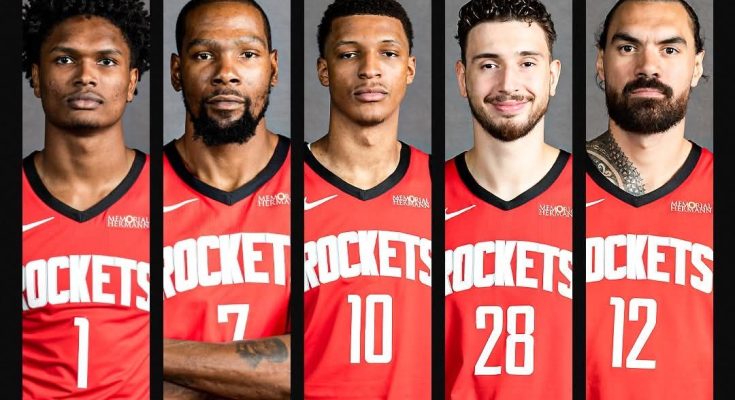The Houston Rockets are making a statement before the ball even tips off on opening night. When they roll out their starting five, the total height of their lineup will add up to a staggering 411 inches — nearly 34 feet of combined basketball talent, length, and athleticism. In a league that’s seen the rise of small ball and perimeter-heavy offenses, the Rockets are choosing a different route. They’re embracing size, physicality, and versatility in a way that hasn’t been seen since the dominant frontcourts of the early 2000s. This isn’t just about being tall; it’s about using that size to dictate games, protect the rim, and overwhelm opponents on both ends of the floor.
The lineup is a bold blend of youth, power, and length, featuring players who can switch across multiple positions and make their presence felt in every area of the court. Standing tall and imposing, this unit will not just look intimidating — it will play that way too. The Rockets have quietly built one of the most physically gifted teams in the NBA, and their opening-day lineup is a reflection of how far the franchise has come since their rebuild began just a few years ago.
At the core of this towering group is center Alperen Şengün, who stands at 6-foot-11. The Turkish big man has blossomed into one of the most skilled young centers in the league. Known for his old-school post moves, dazzling footwork, and uncanny passing vision, Şengün provides the Rockets with a unique interior playmaker. While most modern bigs stretch the floor or serve primarily as lob threats, Şengün blends finesse and intelligence, often orchestrating plays from the low block or the high post. His basketball IQ has drawn comparisons to the likes of Nikola Jokić, and with the added size around him, he’ll have even more freedom to control the tempo and facilitate Houston’s offense.
Flanking Şengün in the frontcourt is 6-foot-10 forward Jabari Smith Jr., whose length and versatility make him the perfect modern power forward. Smith’s development has been steady, and his ability to guard multiple positions gives the Rockets the flexibility to switch defensively without losing size or rim protection. On offense, he’s become increasingly confident in his shooting stroke, capable of hitting shots from deep and spacing the floor. When Smith is locked in, his combination of height, mobility, and shooting range gives Houston a two-way weapon who can seamlessly complement Şengün’s inside play.
Then there’s the towering presence of 7-foot-1 rookie or rotation big (likely an addition like Steven Adams or a long-armed forward like Dillon Brooks if slotted up), giving the Rockets an extra layer of protection in the paint. This third frontcourt player adds the final inches needed to push the lineup total to that 411 mark. His role will likely involve rebounding, setting hard screens, and deterring drives — the kind of physical tasks that allow the team’s young guards to focus more on offense. Houston has often lacked an anchor who can absorb contact and close off the lane, and this addition ensures that no easy buckets come near the rim.
On the wings, Houston’s size advantage continues. Dillon Brooks, listed at 6-foot-7, brings muscle, energy, and defensive nastiness. His bulldog mentality is something this young team has embraced, and he sets the tone on the perimeter. While Brooks has faced criticism in the past for shot selection or fiery on-court antics, there’s no questioning his commitment to defense and team toughness. When Brooks locks in on an opposing scorer, it changes the entire defensive dynamic. His length, coupled with his physical frame, allows the Rockets to match up against elite wings without constantly needing help. That individual defense will prove vital, especially when the Rockets want to keep their bigs near the basket.
At the point of attack, Jalen Green — standing 6-foot-6 — completes the lineup. His athleticism, quickness, and improved defensive instincts allow him to thrive as the smallest player in this massive group. Green’s growth has been one of Houston’s most important storylines, evolving from a raw scorer into a more polished guard who understands tempo and shot selection. His height and wingspan also make him a threat in transition and a much-improved on-ball defender. Surrounded by tall, switchable teammates, Green can focus on pushing the pace, attacking the rim, and using his speed to balance out the team’s size advantage.
Together, this lineup isn’t just tall — it’s dynamic. They can crash the glass, block shots, and still run the floor. The combination of Green’s speed, Brooks’ strength, Smith’s versatility, and Şengün’s craft creates a well-rounded unit that can adjust to any style of play. What makes this particularly fascinating is how it represents a philosophical shift in Houston’s strategy. Under coach Ime Udoka, the Rockets are moving away from the chaotic, freewheeling approach of their rebuild years and embracing a structured, defensive-minded identity. Udoka, known for his defensive emphasis during his Boston tenure, has been clear about his desire to build a team that competes with physicality and discipline.
The 411-inch lineup fits that vision perfectly. It allows the Rockets to trap, switch, and recover without giving up mismatches. In today’s NBA, where spacing and shooting are paramount, having players who can guard multiple positions without sacrificing size is invaluable. With this group, Udoka can deploy different defensive looks — switching one through five, playing drop coverage, or even using zone schemes to clog driving lanes. The result could be a suffocating defense that ranks among the league’s best if the players buy in fully.
On offense, the size also opens up intriguing possibilities. The Rockets can dominate the offensive boards, create second-chance opportunities, and force opponents to collapse in the paint. Şengün’s passing can unlock shooters like Smith and Brooks on the perimeter, while Green’s slashing can exploit slower defenders. Transition basketball will be another strength — few teams can run the floor with this combination of athleticism and height. Imagine a 7-foot player grabbing a rebound, pushing the ball up the floor, and dishing to Green or Smith for an easy dunk. That’s the kind of basketball that excites fans and demoralizes opponents.
What’s perhaps most exciting for Rockets supporters is that this lineup showcases how well their rebuild has been executed. Each player fits a role, complements the others, and contributes to a collective identity that feels sustainable. For years, Houston cycled through roster experiments, trying to find the right mix of youth and experience. Now, they appear to have struck gold with a group that can grow together.
The psychological impact of a tall, cohesive unit shouldn’t be underestimated either. Teams facing the Rockets will immediately feel the physical presence of their lineup. Driving to the rim becomes a daunting task when every path is guarded by a wall of arms and bodies. Opponents will have to settle for contested jumpers, and that’s exactly what Udoka wants. Rebounding battles will also heavily favor Houston; with so much length on the floor, even long rebounds will likely find their way into Rocket hands.
The 411-inch total might sound like a random statistic, but in reality, it symbolizes something deeper. It’s a declaration that the Rockets are ready to dominate with size and skill — a contrast to the undersized lineups that have defined much of the modern NBA. While teams like the Warriors and Celtics have relied on speed and spacing, Houston is betting that physical dominance can still win in 2025. It’s a gamble rooted in basketball fundamentals: defense, rebounding, and interior control.
There will, of course, be challenges. Big lineups can sometimes struggle with quick ball movement, especially against teams that spread the floor with shooters. Transition defense will need to be sharp, as opponents will try to exploit Houston’s height by pushing the tempo. The offense will also need balance — relying too heavily on post-ups or isolations could slow down the pace. However, if the Rockets can blend their inside dominance with efficient perimeter play, they could surprise a lot of people.
Another factor that works in their favor is depth. Even beyond this massive starting five, Houston’s bench carries length and athleticism, allowing Udoka to maintain a similar style throughout the game. Players like Amen Thompson, Tari Eason, and Cam Whitmore bring versatility and energy, ensuring the Rockets never lose their edge when substitutions occur. It’s the kind of roster construction that reflects careful planning and a clear vision for the future.
Opening day will serve as the first real test for this giant lineup. The basketball world will be watching closely, intrigued by how the Rockets execute their plan. Will they overwhelm opponents physically, or will smaller, faster teams find ways to outmaneuver them? Regardless of the outcome, it’s clear that Houston is sending a message: they’re not here to rebuild anymore — they’re here to compete.
For a franchise that’s endured years of growing pains, this feels like the start of something meaningful. The 411-inch lineup represents the culmination of patience, smart drafting, and a commitment to identity. It’s a symbol of where the Rockets have been and where they’re going. They’ve traded chaos for structure, youth for maturity, and inconsistency for purpose. And if their size translates to wins, they might just usher in a new trend across the league — one where height, toughness, and skill coexist in perfect harmony.
So when the Rockets take the court on opening night, fans won’t just be watching another game — they’ll be witnessing the beginning of a bold new chapter. Every inch of that 411 will matter, every rebound will send a message, and every blocked shot will echo the franchise’s resurgence. In a league obsessed with versatility, Houston has found its own version of it — through towering presence, relentless defense, and a fearless embrace of their strengths. The Rockets aren’t just tall; they’re built to rise.



